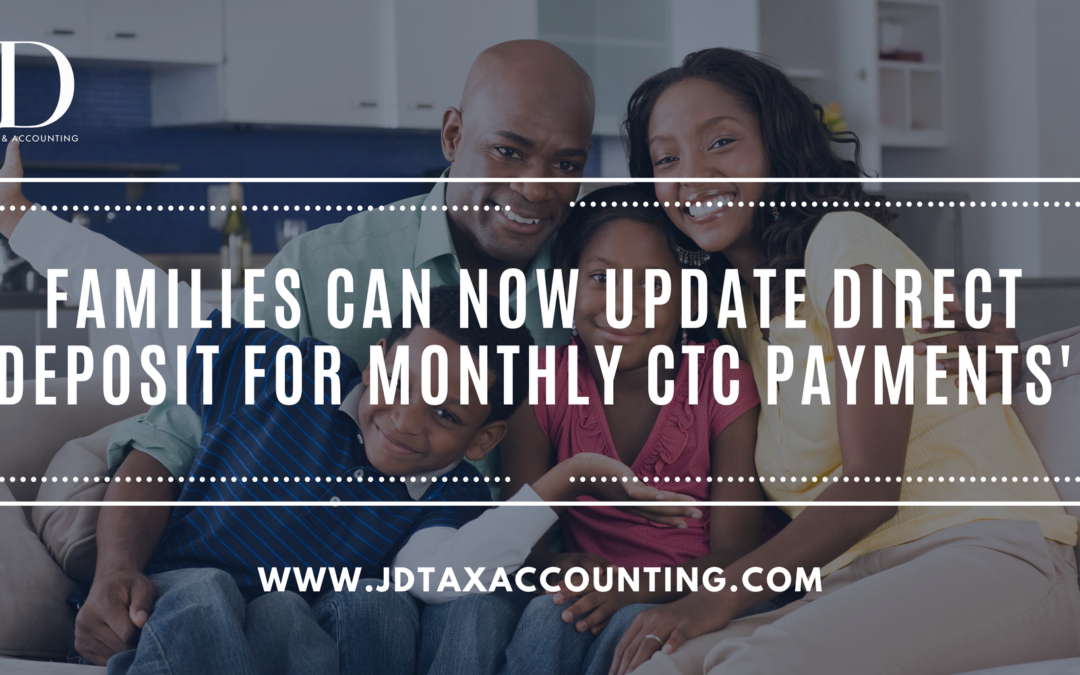Families Can Now Update Direct Deposit for Monthly CTC Payments
Good news! You can now update your bank information much easier and faster! Thanks to the IRS upgraded tools, you can quickly and easily get your monthly Child Tax Credit Payment.
FAQS:
1. What exactly is the child tax credit?
A tax credit to assist families in alleviating their financial burden. If you have children under 17, you are most likely eligible for Child Tax Credit payments.
2. How Will Child Tax Credit Payments Be Made Monthly?
The child tax credit payments will be made monthly via direct deposit, paper check, or debit card.
In general, monthly payments will be made to eligible families who have filed a federal income tax return for either 2019 or 2020 or registering for an Economic Impact Payment using the Non-Filers tool on IRS.gov. An eligible family who has taken any of these steps is not required to do anything else to receive their payments.
Eligible families will receive early compensation in the form of a check or direct transfer. Each payment will be up to $300 per month for children under six and up to $250 per month for children aged six to seventeen.
On the following dates, the IRS will make advance Child Tax Credit payments: July 15, August 13, September 15, October 15, November 15, and December 15. Tax returns received by June 28 will be reflected in the July 15 batch of monthly payments.
3. How can you ensure that your Child Tax Credit payment reaches the correct bank account?
The IRS uses direct deposit account information from your most recent tax return to identify where the checks are routed. If you do not supply such information, a physical check will be mailed to the address on file.
4. What happens if I fail to file a federal income tax return?
The child tax credit is typically only available to people with earned income. However, as part of the American Families Plan stimulus assistance bill temporary increase of the credit, you can now receive it regardless of whether you worked or filed a tax return.
The IRS has created a Non-Filer Sign-up Tool for all eligible families to register for the advance child tax credit to assist you in claiming this money. You must provide your personal information, including your date of birth, Social Security number, mailing address, bank routing, and account numbers, income (if any), and the number of qualifying dependents. Debit cards will eventually be mailed out and filled with each monthly benefit for those who do not have a bank account. However, the IRS has not yet issued a payment schedule for these and has stated that the cards will come later than the direct deposit payments.
5. Who Qualifies for Monthly Child Tax Credit Payments?
The IRS announced the launch of a new online tool called the Advance Child Tax Credit Eligibility Assistant on Wednesday to assist families in determining whether they are eligible for the advanced payments and, if so, how much money they will get.
Parents with an AGI of more than $150,000 for joint filers or $112,500 for heads of households will not be eligible for the full benefit, but the majority of families will qualify for at least a portion of it. The benefit begins to phase away until completely disappearing at $440,000 for joint filers and $240,000 for heads of households.
Parents who are married and filed a joint tax return in 2020 with an adjusted gross income (AGI) of $150,000 or less, and head of household filers with an AGI of less than $112,500, are eligible for the maximum monthly payments this year. In addition, single filers earning less than $75,000 can also qualify for the full benefit, although the vast majority of eligible single parents can file as head of household.
6. When Will Child Tax Credit Payments Be Made Monthly?
The IRS and Treasury Department announced on July 15 that parents would receive their first monthly payment. After that, payments will be made on the 15th of each month, unless it falls on a holiday or weekend. According to the agencies, this will allow families who receive the funds to organize their budgets around it.
7. Can parents who share custody of their children use the child tax credit?
With the first two stimulus checks, parents who were not married but had joint custody of a kid might each receive a payment for the same child if they had claimed the child on their taxes in alternating years. Congress removed the loophole for the third stimulus checks with the most recent stimulus package.
The IRS has special criteria in place for parents who share custody of a child, including who is entitled to a payment. Furthermore, parents who pay little to no federal tax will receive the entire amount they are eligible for, whereas previously, lower-income families were excluded.
8. How to Use the IRS Child Tax Credit Eligibility Assistant?
Before you begin, make sure you have a copy of your 2020 tax return or your 2019 tax return if you haven’t yet filed your taxes for this year. If you don’t have your tax return, you can use your filing status, the number of children you claimed, and an estimate of your total income for 2020. Next, proceed to the ‘Advance Child Tax Credit Eligibility Assistant tool page on the IRS website, then click on the ‘Check Your Eligibility.
9. What does it mean to opt-out of monthly payments this 2021?
Even after payments begin, families have the option of canceling all future monthly payments. They do it by using the unenroll option of the Child Tax Credit Update Portal. Eligible families who make this decision will still get the remainder of their Child Tax Credit as a lump amount when they file their 2021 federal income tax return next year. However, to halt all payments beginning in August and continuing through the rest of 2021, they must unenroll by August 2, 2021.
10. What happens if a check does not arrive on the appointed date?
One thing to keep in mind is that the IRS is aiming for specific payment dates. So if you have set up direct deposit with the IRS, you may see a pending payment before the actual closing date. That means you won’t be able to access the money right now, but it’s on its way.
If you receive your payment by mail or in the form of an EIP card, it may take longer to arrive. If enough time has passed and you are still concerned about a problem, you can use the IRS web interface to correct information. You should also notify the IRS if you have relocated and not just on the US Postal Service.


